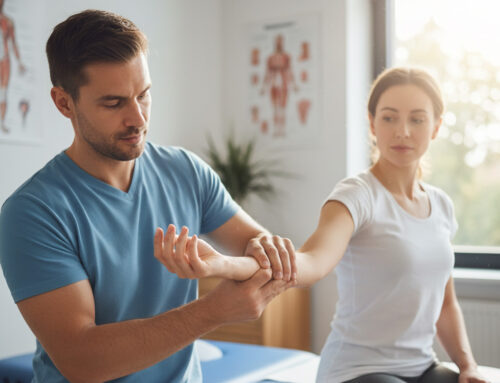Back Pain and Artificial Intelligence: What You Need to Know
By: Dr. Kevin McIntyre B.Kin., DC
For this blog, I thought it would be interesting to see what artificial intelligence recommended for the management of lower back pain. As an experiment, I asked the ChatGPT program, “What are the best exercises for lower back pain?” The results are in quotes below…
“Pelvic Tilt: Lie on your back with knees bent and feet flat on the floor. Tighten your abdominal muscles and flatten your lower back against the floor by tilting your pelvis upward slightly. Hold for a few seconds and release. Repeat 10-15 times.”

Pelvic tilts were very popular for lower back pain management in the 1980s. They aren’t bad for your back, but there certainly isn’t any scientific evidence to recommend them. I don’t think I’ve ever recommended them to a patient who is experiencing lower back pain, but that doesn’t mean it’s bad for you or harmful, I just simply believe there are much better exercises that will likely accomplish more. I’m surprised and somewhat disappointed that artificial intelligence had this as the first suggestion!
“Bridge: Lie on your back with knees bent and feet flat on the floor. Lift your hips off the floor until your shoulders, hips, and knees are in a straight line. Hold for a few seconds, then slowly lower back down. Repeat 10-15 times.”

The bridge isn’t an exercise that will solve all your problems, but unlike the pelvic tilt, this is an exercise that I have recommended many times over the years. It’s a great way to activate the gluteal muscles and assist patients in building confidence in their movements, especially when improving hip extension. The bridge is usually a good, safe exercise for patients and a reasonable recommendation.
“Cat-Cow Stretch: Start on your hands and knees (hands under shoulders, knees under hips). Arch your back upward like a cat, pulling your belly button toward your spine. Hold for a few seconds, then release and let your back sway downward, lifting your head and tailbone toward the ceiling (cow pose). Repeat this stretch 10-15 times.”

This is an exercise that I recommend quite regularly. It’s quite safe, has “some” evidence to support it, and it’s easy for most people to grasp. In fact, I often use it during my assessment to get a general understanding of how a patient moves and the quality of their lumbar motor control. I often describe it to patients as a puddle freezing in the winter. If you slosh the water around in the puddle, it won’t freeze over. The lumbar spine likes to stiffen up and feel rigid when irritated, so this exercise is like sloshing the puddle around and is usually a helpful way to remind the joints how to move.
“Partial Crunches: Lie on your back with knees bent and hands behind your head. Tighten your abdominal muscles and raise your shoulders off the floor while keeping your lower back on the ground. Hold for a few seconds, then slowly lower back down. Repeat 10-15 times.”

Abdominal exercises are often debated among trainers and rehabilitation professionals. Many practitioners will read this blog and disagree on whether partial crunches are safe for the lumbar spine. In my opinion, the lumbar spine is generally more robust and tolerant than many people think and a partial crunch can be a reasonable suggestion. The suitability of an exercise is very individual, and if a person is in pain, it’s important to speak with an experienced professional who can assist. Strengthening the muscles around the spine is a good idea, but if you’re in pain, it might not be the right time for these exercises.
Child’s Pose: Start on your hands and knees, then sit back on your heels with your arms stretched out in front of you. Lower your forehead to the floor and hold for 20-30 seconds while breathing deeply.

Pelvic Clocks: Lie on your back with knees bent and feet flat on the floor. Imagine your pelvis as a clock face; gently tilt your pelvis to 12 o’clock (towards your head), then to 6 o’clock (towards your feet), then 3 o’clock (to the right), and finally 9 o’clock (to the left). Perform this movement slowly and smoothly for 1-2 minutes.

Knee-to-Chest Stretch: Lie on your back with knees bent and feet flat on the floor. Bring one knee up towards your chest and hold for 20-30 seconds. Switch legs and repeat 2-3 times on each side.

These three recommendations (child’s pose, pelvic clocks and knee-to-chest stretches) are debatable recommendations. Many professionals would disagree on whether these are good exercises for lower back pain. In my experience and with my approach to spinal rehabilitation, I often suggest patients with acute lower back pain hold off on these types of stretches in the very early days of pain. This is not because they will damage your spine. They are not inherently harmful exercises. In my experience, they can perpetuate the irritation of an irritated spine, and in the short term, they may not be helpful. However, if a patient with lower back pain informed me that they were doing these exercises and it was helping them, then by all means, I would likely recommend that they continue using them! There are no hard rules. For most cases of severe lower back pain, I usually suggest cat-cow exercises, walking and changing positions for the first few days until we get an idea of what their lower back “likes” and “dislikes.”
In short, it’s not really a wise decision to ask the internet how you should manage your individual condition. That includes this blog. The exercises and thoughts shared in this blog are not recommendations for you; they are generalizations pertaining to common lower back pain. Artificial intelligence is not a replacement for an individualized, in-person assessment of your condition followed by evidence based, logical exercises based on your pain presentation. The right exercises for a person depend on many factors, the most obvious being how they tolerate different movements. A one-size-fits-all approach to managing lower back pain is not advised.







